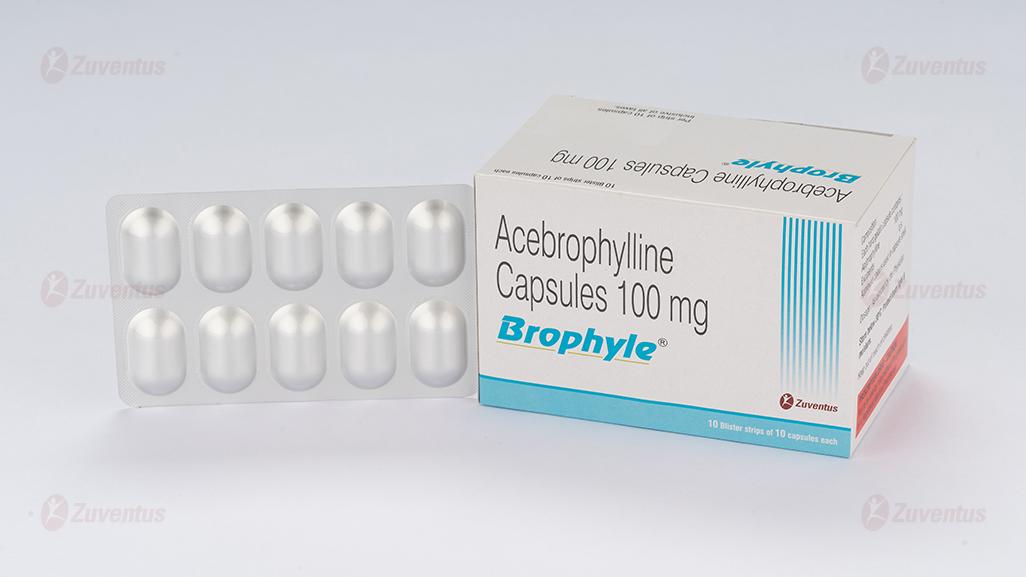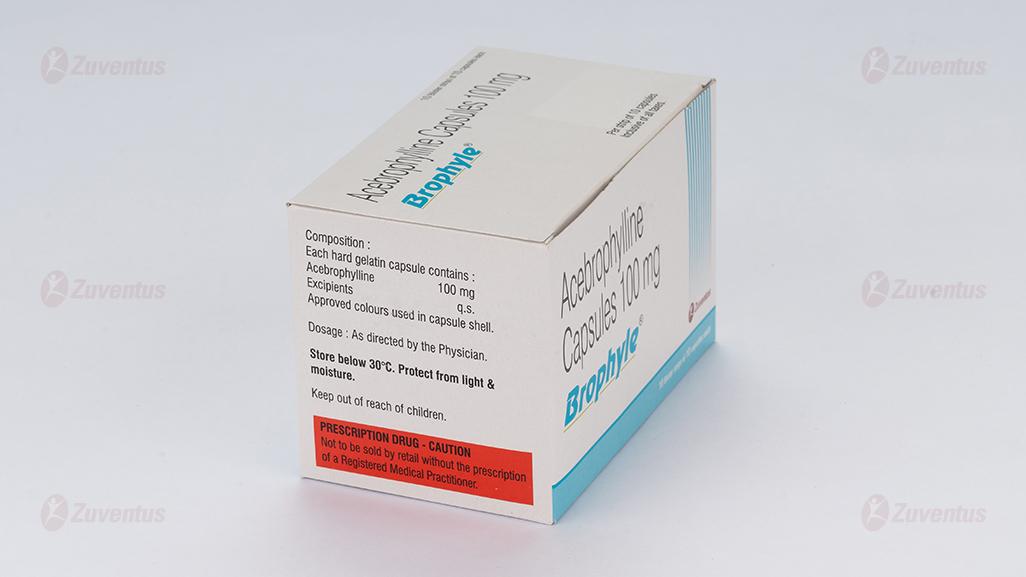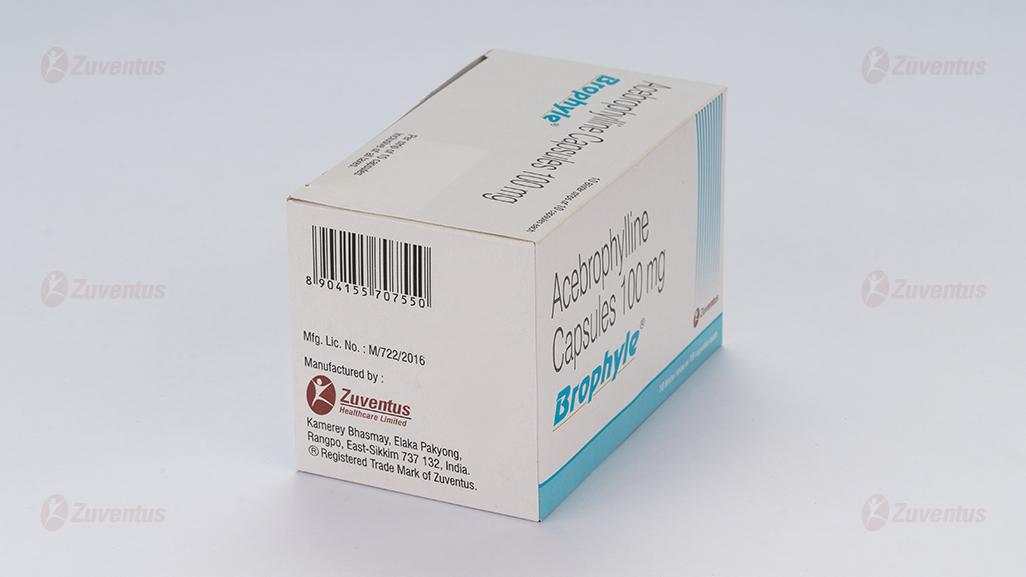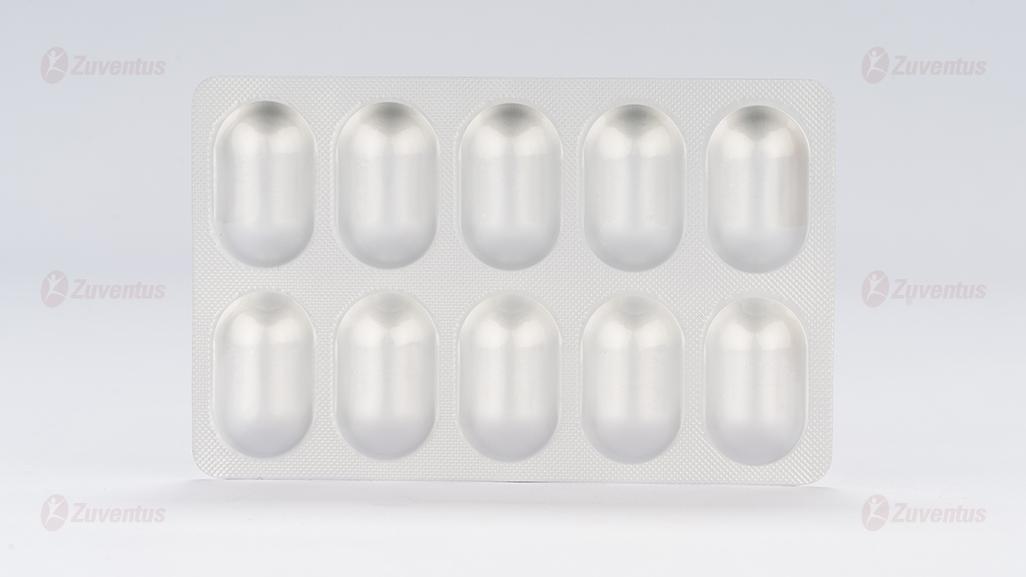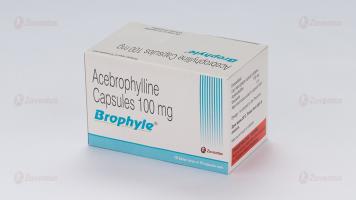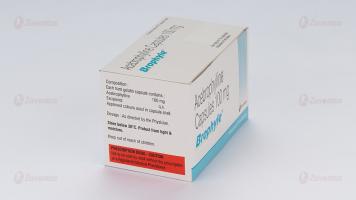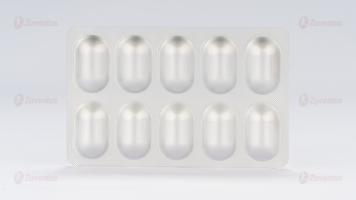Brophyle Capsule
Therapy Area
Respiratory
1.0 Generic name
Acebrophylline Capsules 100 mg
2.0 Qualitative and quantitative composition
Each hard gelatin capsule contains
Acebrophylline 100 mg
Excipients q.s.
3.0 Dosage form and strength
Capsule 100 mg
4.0 Clinical particulars
4.1 Therapeutic indication
For the treatment of chronic obstructive pulmonary disease, bronchial asthma and bronchitis.
4.2 Posology and method of administration
Adults
The usually recommended dose of acebrophylline for adults is one Brophyle Capsules twice daily. Acebrophylline capsules are not recommended for use in children (who may find difficulty in swallowing capsules).
In elderly patients dosage may be adjusted if required.
4.3 Contraindications
- Hypersensitivity to ambroxol, acebrophylline, theophylline or any other xanthine derivative
- Patients suffering from acute myocardial infarction
- Patients with hypotension, hemodynamic instability, and arrhythmias
- Patients with renal disease or liver disorder
4.4 Special warnings and precautions for use
Careful monitoring is recommended for patients with congestive heart failure, chronic alcoholism, hepatic dysfunction, or viral infections. Caution should be exercised in patients with cardiac arrhythmias, other cardiovascular diseases, hyperthyroidism or hypertension, gastric and duodenal ulceration or convulsive disorders. Patients with hepatic and renal insufficiency should take it with caution.
4.5 Drugs interactions
The following reduce clearance and a reduced dosage may therefore be necessary to avoid side-effects: allopurinol, cimetidine, ciprofloxacin, corticosteroids, diltiazem, erythromycin, frusemide, isoprenaline, oral contraceptives, thiabendazole and verapamil, doxycycline, amoxicillin etc.
Xanthines can potentiate hypokalaemia resulting from beta2-agonist therapy, steroids, diuretics and hypoxia. Particular caution is advised in severe asthma. It is recommended that serum potassium levels are monitored in such situations.
No clinically relevant unfavourable interactions with other medications have been reported.
4.6 Use in special populations
Pregnancy
Acebrophylline is not recommended in pregnancy as well as during parturition.
Lactation
The safety of acebrophylline is not established during lactation period. Hence the use of acebrophylline is not advisable in lactating mothers.
4.7 Effects on ability to drive and use machines
No studies on the effect on the ability to drive and use machines have been performed.
4.8 Undesirable effects
Transient nausea and dizziness may occur on taking this drug, but these effects are reversible. On cessation of therapy, these symptoms tend to disappear.
The commonly reported adverse effects with acebrophylline include abdominal discomfort, stomach/abdominal distension, vomiting, abdominal pain, diarrhea, constipation, heart burn, loss of appetite, esophageal bleeding, rashes, urticaria, itching, drowsiness, difficulty in breathing, leukocytosis, and nasal inflammation. If chills and fevers occur, the drug should be immediately discontinued.
Other rarely reported adverse events include headache, occasional numbness including numbness in arm, insomnia, tachycardia, fatigue, hypertension, albuminuria, glycosuria, hypotension and occasionally hyperglycemia.
Reporting of suspected adverse reactions
Reporting suspected adverse reactions after authorisation of the medicinal product is important. It allows continued monitoring of the benefit/risk balance of the medicinal product. Healthcare professionals are asked to report any suspected adverse reactions via email to: medico@zuventus.com
Website: https://www.zuventus.com/drug-safety-reporting
By reporting side effects, you can help provide more information on the safety of this medicine.
4.9 Overdose
Nausea, vomiting (which is often severe), epigastric pain and haematemesis. Pancreatitis if abdominal pain persists. Restlessness, hypertonia, exaggerated limb reflexes and convulsions. Tachycardia is common.
Symptomatic treatment should be provided.
5.0 Pharmacological properties
5.1 Mechanism of Action
Acebrophylline is a compound which has been found to act as a bronchodilating, mucoregulating and anti-inflammatory drug due to its components theophylline-7-acetate and ambroxol.
Theophylline-7-acetate, as with other xanthinic derivatives, has a bronchodilator effect due to inhibition of the intracellular phosphodiesterases, followed by an increase of adenosine monophosphate cyclic levels, which promote the relaxation of bronchial muscles.
Ambroxol modifies the mucous gel phase of secretions by decreasing the viscosity and increasing the serous gel phase. It increases the mucociliary clearance by stimulating cilia motility.
5.2 Pharmacodynamic properties
Acebrophylline inhibits phospholipase A2 and phosphatidylcholine leading to lesser production of the powerful pro-inflammatory substances like leukotrienes and tumor necrosis factor. By inhibiting the synthesis and release of these inflammatory mediators, acebrophylline reduces inflammation, a key factor in airway obstruction, especially in chronic forms.
5.3 Pharmacokinetic properties
In healthy volunteers, given 200 mg oral acebrophylline, the two components of the molecule ambroxol and theophylline-7 acetic acid are released in the stomach and absorbed in the intestine, reaching optimal concentrations of ambroxol within 2 hours and of theophylline-7 acetic acid after 1 hour. The plasma half-life varies from 4 to 9 hours after oral administration. The drug is metabolized in the liver and eliminated renally.
6.0 Nonclinical properties
6.1 Animal Toxicology or Pharmacology
Negative interference has been reported between theophylline and erythromycin and in animal’s simultaneous administration of theophylline together with erythromycin estolate at doses that alone are non-toxic enhanced the toxicity of the former, as indicated by the drastic drop in the LD50, i.e. the dose causing the death of half the animals. In similar experimental conditions, acebrophylline was not affected by simultaneous use of erythromycin, and not only was there no reduction in the LD50 but in some cases it was actually higher, indicating the safety of the two components as regards their potential tolerability in patients.
7.0 Description
Acebrophylline, an airway mucoregulator and anti-inflammatory agent is a combination product of ambroxol and theophylline 7 acetic acid.
8.0 Pharmaceutical particulars
8.1 Incompatibilities
Not applicable
8.2 Shelf-life
Refer on pack
8.3 Packaging information
8.4 Storage and handing instructions
Store below 30°C. Protect from light & moisture.
9.0 Patient counselling information
- You have been prescribed Acebrophylline for prevention and treatment of asthma and chronic obstructive pulmonary disease (COPD).
- It should be taken at the same time each day, preferably in the evening after food.
- It does not work right away and should not be used to relieve sudden breathing problems. Always keep a fast-acting (rescue) inhaler with you.
- Your doctor may take regular blood test to monitor potassium level and the level of this medicine in your body.
- Notify your doctor if you have ever been diagnosed with kidney, liver or heart disease, or if you have a smoking history. Your dose may need to be adjusted.
- Do not discontinue use without consulting your doctor, even if you feel better.
12.0 Date of revision
18.05.2022
About Leaflet
Please read this leaflet carefully before you start using this medicine because it contains important information for you.
- Keep this leaflet. You may need to read it again.
- If you have any further questions, ask your doctor or pharmacist.
- This medicine has been prescribed for you. Do not pass it on to others. It may harm them, even if their signs of illness are the same as yours.
- If you get any side effects, talk to your doctor or pharmacist. This includes any possible side effects not listed in this leaflet.
What is in this leaflet
- What Brophyle is and what it is used for
- What you need to know before you use Brophyle
- How to use Brophyle
- Possible side effects
- How to store Brophyle
- Contents of the pack and other information
1. What Brophyle is and what it is used for
Brophyle Capsules contain the active substance acebrophylline, which is used to treat chronic obstructive pulmonary disease (COPD), bronchial asthma, and bronchitis. It helps to relax the muscles in the airways and reduces inflammation, making it easier to breathe.
2. What you need to know before you take Brophyle
Do not take Brophyle Capsules if you:
- Are allergic to acebrophylline, ambroxol, theophylline, or any other xanthine derivative.
- Have had a recent heart attack.
- Suffer from low blood pressure, unstable blood circulation, or irregular heartbeats.
- Have severe kidney or liver disease.
Warnings and precautions:
- Inform your doctor if you have heart failure, chronic alcoholism, liver dysfunction, or viral infections.
- Use with caution if you have heart arrhythmias, cardiovascular diseases, hyperthyroidism, hypertension, stomach ulcers, or convulsive disorders.
- Patients with liver or kidney insufficiency should use this medicine with caution.
Other medicines and Brophyle Capsules:
- Allopurinol, cimetidine, ciprofloxacin, corticosteroids, diltiazem, erythromycin, frusemide, isoprenaline, oral contraceptives, thiabendazole, and verapamil: These medicines can reduce the clearance of acebrophylline, potentially increasing the risk of side effects. Your doctor may need to adjust your dose.
- Doxycycline and amoxicillin: These antibiotics can interact with acebrophylline, requiring careful monitoring.
- Beta2-agonists, steroids, diuretics, and hypoxia: Xanthines like acebrophylline can potentiate hypokalaemia (low potassium levels) caused by these treatments. Monitoring of serum potassium levels is recommended, especially in severe asthma. No clinically relevant unfavourable interactions with other medications have been reported, but always inform your doctor about all the medicines you are taking.
Pregnancy and breastfeeding:
- Brophyle Capsules are not recommended during pregnancy or breastfeeding.
Driving and using machines:
- No studies have been conducted on the effects of Brophyle Capsules on the ability to drive or use machines. Use caution until you know how the medicine affects you.
Important Precautions
- You have been prescribed Acebrophylline for prevention and treatment of asthma and chronic obstructive pulmonary disease (COPD).
- It should be taken at the same time each day, preferably in the evening after food.
- It does not work right away and should not be used to relieve sudden breathing problems. Always keep a fast-acting (rescue) inhaler with you.
- Your doctor may take regular blood test to monitor potassium level and the level of this medicine in your body. Notify your doctor if you have ever been diagnosed with kidney, liver or heart disease, or if you have a smoking history. Your dose may need to be adjusted. Do not discontinue use without consulting your doctor, even if you feel better.
3. How to take Brophyle
Always take this medicine exactly as your doctor has told you. Check with your doctor if you are not sure.
Adults:
- The usual dose is one capsule twice daily, preferably in the evening after food.
Elderly:
- Dosage may need to be adjusted.
Children:
- Not recommended for children who may have difficulty swallowing capsules.
If you use more Brophyle than you should
Tell your doctor if you accidentally use more than you were told.
If you forget to use Brophyle
If you forget to take at the right time, use it as soon as you remember, then carry on as before. Do not take a double dose to make up for a forgotten dose.
If you stop using Brophyle
Do not stop your treatment even if you feel better unless told to do so by your doctor. If you have any further questions on the use of this product, ask your doctor or pharmacist.
4. Possible side effects
Like all medicines, this medicine can cause side effects, although not everybody gets them.
Common side effects:
- Abdominal discomfort, stomach distension, vomiting, abdominal pain, diarrhea, constipation, heartburn, loss of appetite, esophageal bleeding, rashes, urticaria, itching, drowsiness, difficulty breathing, leukocytosis, nasal inflammation.
Rare side effects:
- Headache, numbness, insomnia, tachycardia, fatigue, hypertension, albuminuria, glycosuria, hypotension, hyperglycemia.
Reporting of side effects
If you get any side effects, talk to your doctor, pharmacist or nurse. This includes any possible side effects not listed in this leaflet. You can also report side effects directly: Website: www.zuventus.com in and click the tab “Drug Safety Reporting” located on the top end of the home page. Website link: https://www.zuventus.com/drug-safety-reporting. By reporting side effects, you can help provide more information on the safety of this medicine. You can also report the side effect with the help of your treating physician.
5. How to store Brophyle
- Keep this medicine out of the sight and reach of children.
- Store below 30°C. Protect from light & moisture.
- Do not use this medicine after the expiry date which is stated on the label and carton after EXP.
- The expiry date refers to the last day of that month.
Do not throw away any medicines via wastewater or household waste. Ask your pharmacist how to throw away medicines you no longer use. These measures will help protect the environment.
6. Contents of the pack and other information
What Brophyle Capsules contain:
- The active substance is acebrophylline 100 mg.

